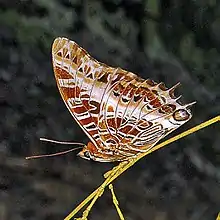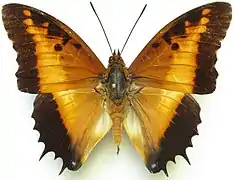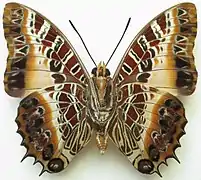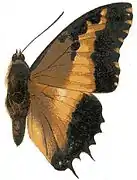Charaxes pollux
Charaxes pollux, the black-bordered charaxes, is a butterfly in the family Nymphalidae.
| Charaxes pollux | |
|---|---|
 | |
| Charaxes pollux, underwings | |
| Scientific classification | |
| Domain: | Eukaryota |
| Kingdom: | Animalia |
| Phylum: | Arthropoda |
| Class: | Insecta |
| Order: | Lepidoptera |
| Family: | Nymphalidae |
| Subfamily: | Charaxinae |
| Tribe: | Charaxini |
| Genus: | Charaxes |
| Species: | C. pollux |
| Binomial name | |
| Charaxes pollux | |
| Synonyms | |
| |
Distribution and habitat
Charaxes pollux can be found in Guinea, Sierra Leone, Liberia, Ivory Coast, Ghana, Nigeria, Cameroon, Equatorial Guinea, the Central African Republic, Gabon, Angola, the Republic of the Congo, the Democratic Republic of the Congo, Zambia, Rwanda, Burundi, Sudan, Uganda, Kenya, Tanzania, Malawi, Mozambique and Zimbabwe.[2][3] The habitat consists of Afrotropical forests, gallery forests and heavy woodland.
Description
In Charaxes pollux forewings can reach a length of 36–45 millimetres (1.4–1.8 in) in males, of 41–51 millimetres (1.6–2.0 in) in females. The upperside of the forewings is tawny in the basal area, with a broad ochraceous orange post-discal band and a black wide border. The upperside of the hindwings is rather similar, but it has a whitish discal area and pale blue submarginal spots. The underside is red-chestnut, with a white discal band and a series of black bars bordered with white. The edge of the wings is sharply dentate.[4] Seitz-The discal band of the upper surface is dark orange-yellow; the tails of the hind wing only 3—4 mm. in length; the hindwing above with a deep black, unspotted marginal band, 9—10 mm. in breadth; the forewing with small brown marginal spots. On the under surface the black, white-bordered spots are almost as numerous as in hansali and on the hindwing there are three in cellule 8 and two in cellule 7. Sierra Leone to Angola and Uganda. — geminus Rothsch. differs in having small brown marginal spots on the hindwing above, at least in cellules 4—6. Manicaland, Nyassaland, Kilimandjaro.[5] Similar to Charaxes ansorgei but male lacking a white band on the hindwing upperside [6]
Gallery
 C. p. pollux from the CAR - upperside
C. p. pollux from the CAR - upperside C. p. pollux from the CAR - underside
C. p. pollux from the CAR - underside Illustration from Fauna Africana (1910)
Illustration from Fauna Africana (1910)
Subspecies
Subspecies include:[2]
- C. p. pollux (Guinea, Sierra Leone, Liberia, Ivory Coast, Ghana, Nigeria, Cameroon, Central African Republic, Gabon, northern Angola, Congo, Democratic Republic of the Congo, northern and north-western Zambia, Rwanda, Burundi, southern Sudan, Uganda, western and central Kenya, western Tanzania)
- C. p. annamariae Turlin, 1998[7] (Bioko)
- C. p. gazanus van Someren, 1967 (Mozambique: west to area between the Zambezi and Limpopo Rivers), eastern Zimbabwe)
- C. p. geminus Rothschild, 1900[8] (Malawi, Zambia: east of the Luangwa Valley), southern and eastern Tanzania, south-eastern Kenya)
- C. p. maua van Someren, 1967 ([9] northern Tanzania)
- C. p. mira Ackery, 1995 [10] (north-eastern Tanzania)
- C. p. piersoni Collins, 1990 ([11] Zanzibar)
Natural History
Life-sized colour plates and description of the larval and pupal stages of C. pollux and additional related species, illustrated by Dr. V. G. L. van Someren, are readily available.[12] The larvae feed on Sorindeia species, Bersama abyssinica, Deinbollia kilimandsharica, Deinbollia borbonica, Fluggia microcarpa, Securinega virosa and Fluggia virosa.[2] Adults are probably on wing year round. [13]
Notes on the biology of pollux are given by Pringle et al (1994), Larsen (1991), Larsen (2005) and Kielland (1990). [14] [15] [16] [17]
Related species
Historical attempts to assemble a cluster of presumably related species into a "Charaxes jasius Group" have not been wholly convincing. More recent taxonomic revision,[18] corroborated by phylogenetic research, allow a more rational grouping congruent with cladistic relationships. Within a well-populated clade of 27 related species sharing a common ancestor approximately 16 mya during the Miocene,[19] 26 are now considered together as The jasius Group.[18] One of the two lineages within this clade forms a robust monophyletic group of seven species sharing a common ancestor approximately 2-3 mya, i.e. during the Pliocene,[19] and are considered as the jasius subgroup.[18] The second lineage leads to 19 other species within the Jasius group, which are split into three well-populated subgroups of closely related species.
The jasius Group (26 Species):[18]
Clade 1: jasius subgroup (7 species)
Clade 2: contains the well-populated three additional subgroups (19 species) of the jasius Group: called the brutus, pollux, and eudoxus subgroups.[18]
- the pollux subgroup (4 species):
- Charaxes pollux
- Charaxes phoebus
- Charaxes ansorgei
- Charaxes dowsetti
Further exploration of the phylogenetic relationships amongst existing Charaxes taxa is required to improve clarity.
References
- Cramer, P. [1775-1776]. De Uitlandsche Kapellen voorkomende in de drie waereld-deelen Asia, Africa en America. Amsteldam & Utrecht. 1: [vi], xxx, 16 pp., 155 pp.
- "Charaxes Ochsenheimer, 1816" at Markku Savela's Lepidoptera and Some Other Life Forms
- Afrotropical Butterflies: File H - Charaxinae - Tribe Charaxini
- Novitates Zoologicae
- Aurivillius, [P.O.]C. 1908-1924. In: Seitz, A. Die Großschmetterlinge der Erde Band 13: Abt. 2, Die exotischen Großschmetterlinge, Die afrikanischen Tagfalter, 1925, 613 Seiten, 80 Tafeln (The Macrolepidoptera of the World 13).Alfred Kernen Verlag, Stuttgart.
 This article incorporates text from this source, which is in the public domain.
This article incorporates text from this source, which is in the public domain. - Kielland, J. 1990 Butterflies of Tanzania. Hill House, Melbourne and London: 1-363.</refApollo Books, Svendborg, Denmark: 1-595
- Turlin, B. 1998 [New African Charaxinae (Lepidoptera Nymphalidae). Lambillionea 98 (2) (Tome I): 181-189.
- Rothschild, 1900 in Rothschild, W., & Jordan, K. 1900. A monograph of Charaxes and the allied prionopterous genera. Novitates Zoologicae 7: [i-iv], 287-524.
- van Someren , V.G.L. 1967 Revisional notes on African Charaxes (Lepidoptera: Nymphalidae). Part IV. Bulletin of the British Museum (Natural History) (Entomology) 18: 277-316.
- Ackery, 1995 in Ackery, P.R., Smith, C.R., Vane-Wright, R.I., et al. . 1995. Carcasson's African Butterflies: An annotated Catalogue of the Papilionoidea and Hesperioidea of the Afrotropical Region. British Museum (Natural History), London: i-xi, 1-803. Replacement name for Charaxes pollux mirabilis Turlin, 1989. In Henning, 1989. The Charaxinae butterflies of Africa 116, 117 (457 pp.).
- Collins, S. C in Kielland , J. 1990 Butterflies of Tanzania. Hill House, Melbourne and London: 1-363.
- van Someren, V.G.L.; Rogers, Rev. K. St. A. (1928). "The Butterflies of Uganda and Kenya (Part 7) Family Nymphalide - Charaxidi" (PDF). Journal of the East Africa and Uganda Natural History Society. 31–32: 111–113 & 146–149. hosted by Biodiversity Heritage Library (BHL)
- Pringle et al , 1994. Pennington’s Butterflies of Southern Africa, 2nd edition
- Pringle et al , 1994. Pennington’s Butterflies of Southern Africa, 2nd edition
- Larsen, T.B. 1991The Butterflies of Kenya and their Natural History. Oxford University Press, Oxford: i-xxii, 1-490.
- Kielland, J. 1990. Butterflies of Tanzania. Hill House, Melbourne and London: 1-363.
- Larsen, T.B. 2005 Butterflies of West Africa. Apollo Books, Svendborg, Denmark: 1-595 (text) & 1-270 (plates).
- Turlin, B. (2005). Bauer & Frankenbach (ed.). Butterflies of the World: Charaxes 1. Vol. 22. Keltern: Goecke & Evers. pp. 2–3. ISBN 3937783156.
- "Out of Africa again: A phylogenetic hypothesis of the genus Charaxes (Lepidoptera: Nymphalidae) based on five gene regions". Aduse-Poku, Vingerhoedt, Wahlberg. Molecular Phylogenetics and Evolution (2009) 53;463–478
External links
- Images of C. p. pollux (Albertine Rift Project)
- Images of C. p. gazanus Royal Museum for Central Africa (Albertine Rift Project)
- Images of C. p. maua (Albertine Rift Project)
- Images of C. p. mira (Albertine Rift Project)
- Images of C. p. piersoni (Albertine Rift Project)
- C. pollux and all subspecies: images with links to Public Data Portal at BOLDSystems.v4